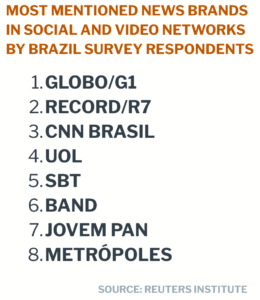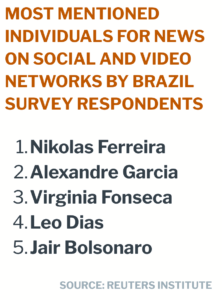The news industry is scrambling to figure out how to define, understand and replicate the success of content creators and influencers in attracting and informing audiences on social media.
Scholars are researching how they operate, news organizations are looking to collaborate or compete, and some journalists are even leaving the newsroom to strike out on their own.
One of the countries feeling the impact of these new players on the news industry most intensely is Brazil. And the numbers show it.
When looking for news, social media users are turning to creators and influencers more than traditional media brands and journalists, according to a recent study from the Reuters Institute for the Study of Journalism.
The data show that 33% of Brazilian respondents say they follow creators and influencers to stay informed, while 30% say they follow news brands and journalists.
“While news creators and influencers draw considerable attention in countries like Mexico and Colombia, Brazil is the only Latin American country in our analysis where survey respondents say they pay more attention to individual creators and personalities for news on social media,” Amy Ross Arguedas, one of the study authors, told LatAm Journalism Review (LJR).

The most mentioned news brands on social and video networks by Brazilian survey respondents. (Credit: Canva Illustration)
Arguedas said several factors help explain this result, such as the high dependence on social media for news consumption in Brazil. She said the research also showed that 54% of respondents use social media to stay informed weekly, while 35% said that the platforms are their main source of news.
Arguedas added that the sheer size of the Brazilian market also plays a role, since, being the largest country in Latin America, the potential audience for journalistic content is much larger than in other countries in the region. Other factors influencing this situation are attraction to content that resonates with specific political views and the media concentration.
“With diverging views around contentious political figures like [former President Jair] Bolsonaro, political polarization may also be playing a role, with certain audiences turning to online influencers for content that resonates with their world views,” Arguedas said. “Lastly, in a country with considerable media concentration, some audiences may find a greater diversity of content outside of traditional news brands.”
Arguedas also noted that, in environments of institutional distrust, individuals with names and faces the public identifies with on a personal level may seem more authentic or trustworthy than news brands that some perceive as distant or disconnected.
The five names for news content on social media that were most frequently mentioned by survey respondents in Brazil were: federal congressman Nikolas Ferreira; Alexandre Garcia, former TV Globo presenter and current commentator on YouTube; Virgínia Fonseca, lifestyle and beauty influencer; Leo Dias, celebrity journalist; and former president Jair Bolsonaro.
Sérgio Lüdtke, coordinator of the News Atlas, which maps journalism initiatives in Brazil, said the growth of the individual shown by the Reuters Institute’s study coincides with his own research into the country’s media.
"The information ecosystem is being redefined by individuals,” Lüdtke told LJR.
However, he added: “They are not a homogeneous group that can be simply classified as news influencers or news creators.”
Lüdtke said that Projor, the Institute for the Development of Journalism and leader of the News Atlas, created a working group to better understand and define the roles of content creators. If necessary, it will update the News Atlas to reflect this field.
“I believe we should all have the humility to understand that we have much to learn from each other,” he said. “We first need to understand the diversity of actors, their processes and the results of their activities. There is work to be done in defining this hybridity, in classifying the roles of these actors who are on the border between classic journalism and communicators who work on third-party platforms.”
Recently, according to the Reuters Institute study, renowned journalists in various countries have been leaving news organizations to establish themselves independently, either because they want more control or because they believe they can earn more money, or both. This trend is driven by the fact that independent creators now operate with a lower cost base, leading to an exodus of talent from many news organizations.

The most mentioned individuals for news on social and video networks by Brazilian survey respondents. (Credit: Canva Illustration)
Lüdtke said this transition of journalists from newsrooms to independent production occurs both out of opportunity and necessity.
"The closure or downsizing of newsrooms opens the door to a broader field, without barriers to entry, where journalists can leverage their networks as social capital," he said.
He adds that being articulate and a good communicator are part of the path to success, but emphasizes that this is not the only profile present today. Lüdtke says that there are also professionals who produce reports and information typical of traditional journalism and who choose to use the platforms as their main distribution channel.
Pedro Doria is a journalist who worked for years in traditional newsrooms before establishing himself online, where he started the YouTube channel Meio, with 356,000 subscribers.
He said that while in traditional journalism, impartiality is valued and political journalists should not reveal partisan preferences, online, the scenario is somewhat different.
"The problem is that when you go online, because of the nature of algorithms, the audience interested in news has a bias and wants to hear the news from their point of view," Doria told LJR. "The internet, it seems to me, demands that you take a transparent political stance. So, I take a clear stance. I am a liberal and I say this, among other things, because I think this is a space for you to educate people politically."
Another crucial change that Doria points out is that news has become a commodity on the internet. In other words, the news itself, such as a speech by a congressman or a bill that has been passed, is already everywhere, so he says that simply sharing this information doesn’t make anyone stand out.
"You won't stand out by reporting the news. You'll stand out through analysis," Doria said. "And these analyses need to surprise, not repeat arguments that are already widely circulating."
The Reuters Institute study found that content creators are having a particularly significant impact in areas such as political commentary, explanatory content and specialized content.
In the case of explanatory content, creators translate news into simpler and more accessible formats, often for younger audiences, drawing on and remixing traditional sources.
In the field of specialized content, creators are building small but sustainable businesses in niches such as technology, football and finance, often with a lower cost base than traditional organizations.
Arguedas said creators have been more adept than traditional organizations at adapting narratives and tone to the demands of social platforms and the tastes of audiences. She also pointed out that they have embraced a broader set of audience needs related to entertainment, lifestyle and specialized content that mainstream media tends to pay less attention to.
“They have also mostly proved better at attracting and keeping attention in fast-changing, algorithmically driven spaces,” she said. “These are all areas where news organizations can potentially learn from creators and influencers.”
Doria, however, is cautious about the idea that traditional media outlets should simply copy influencers. He cited The Atlantic magazine, which found its niche online by leveraging an acerbic edge that has been in its DNA since the 19th century.
"Newspapers can't simply throw away the audience that still expects this kind of work from newspapers because the internet exists," Doria said. "The solution involves diversifying newsrooms and being open to experimentation, but without reinventing the voice of the publication. You need to find on the internet how you can fit that voice in."